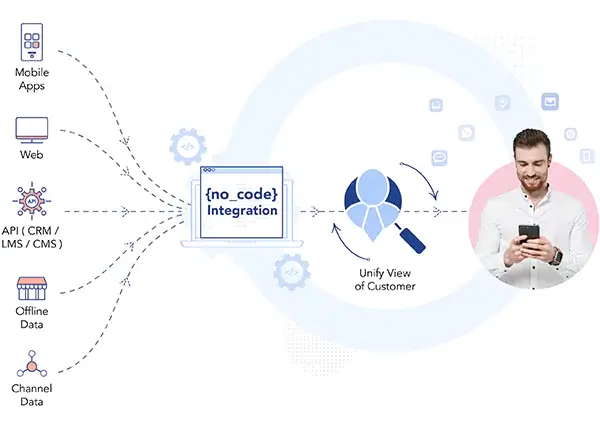Businesses often struggle with managing customer data. Common problems include data spread across many systems, teams working in separate silos, records that do not match, and a lack of clear, timely insights. These problems make it hard to see a full picture of a customer and to take quick action.
A customer data platform for retail can help solve many of these issues. By combining data in one place and keeping profiles consistent, businesses can make better decisions and improve customer experiences. A customer data platform for retail can make these benefits real for store and online teams. Not all solutions are the same, though. A real-time customer data platform offers capabilities that differ from older approaches.
Common Ways to Manage Customer Data
- Spreadsheets: It is simple and familiar. Teams can list customers, track contacts, and run simple reports. But spreadsheets break down as data grows. They create duplicates, suffer from human mistakes, and do not connect easily to other systems.
- Customer relationship management systems (CRMs): CRMs store contact details, sales activities, and account notes. They help sales teams manage pipelines. However, CRMs usually do not collect high volumes of real-time behavior data from websites, apps, or stores. That makes it hard to personalize experiences based on the latest actions.
- Data Warehouses: They help to collect large sets of raw and processed data for analysis. They are powerful for reports and trend studies. But warehouses often work in batches. Data moves on set schedules, so the latest events may not be available right away. This delay limits quick decision-making.
- Marketing Clouds and Email Platforms: Companies can run campaigns and automate messages with these solutions. They focus on execution, but they rely on correct and timely inputs. If data is late or split across systems, campaign relevance drops. Marketing platforms also tend to duplicate profiles when many tools are used together.
Limitations of Traditional Approaches
Each approach has value but also limits. Spreadsheets are cheap and easy but fragile. CRMs are strong for sales but are not built for high-frequency behavioral data. Warehouses are great for deep analysis but slow for immediate action. Marketing clouds execute well but need accurate, unified inputs.
These limits often lead teams to stitch several systems together. That makes processes complex and slows response times. For retail, where customer behavior changes quickly, such delays affect sales and satisfaction.
What is a Real-time Customer Data Platform?
A real-time customer data platform is a system designed to collect, clean, and combine customer signals from many places as they happen. It resolves identities, merges data into a single profile, and updates that profile instantly when new events arrive. The platform then shares those profiles with marketing, commerce, and service systems so actions can be taken without delay.
This approach differs from batch systems because it treats each event as important. Instead of waiting for nightly or hourly jobs, it updates profiles and triggers decisions immediately.
How It Differs from Other Customer Data Management Methods
A retail customer data platform focuses on the needs of stores, websites, apps, and loyalty programs. A retail customer data platform helps link those channels into one profile. Compared with a CRM or warehouse, a customer data platform places the most value on identity resolution and fast updates. It is built to work with live behavior streams and to supply current profiles to execution tools.
Where a marketing cloud might send mass messages based on older data, a real-time customer data platform can support a personal message triggered by a single action, like adding an item to a cart. Such speed makes marketing feel more relevant to the customer.
Practical Retail Examples
Consider a chain of stores that wants to offer in-store staff quick access to customer history. A retail customer data platform can show a salesperson a customer’s recent online views and purchases at the moment the customer enters the store. Staff can offer better recommendations or faster service.
For e-commerce, a customer data platform for retail can power product suggestions that reflect a shopper’s most recent searches. If a user checks a product twice, the platform can prompt a real-time offer or free shipping message to encourage purchase. These timely actions lift conversion rates. A retail customer data platform makes such timely offers possible and measurable.
Another example is a flash sale. A real-time customer data platform lets marketers detect which products are trending and push targeted offers to users who showed interest that day. This reduces wasted spending and improves the chance of a sale.
Integration and Practical Choices
Many retailers keep warehouses and CRMs for deep analysis and long-term records. A customer data platform often sits between those systems and execution tools. It provides current, cleaned profiles, while warehouses hold historical data. This hybrid setup gives both immediate action and long-term insight. A customer data platform for retail should fit the retailer’s scale and channels.
Adoption needs planning. Teams must map data sources, define identity rules, and set governance. Once in place, a real-time customer data platform reduces friction and speeds up campaigns and service.
Bottom Line
Managing customer data with spreadsheets, CRMs, warehouses, and marketing clouds can work for parts of the business, but it often leaves gaps. A retail customer data platform that works in real time removes many of these gaps by unifying profiles, enabling fast personalization, and supporting quick decisions. For retailers that want timely, relevant customer interactions, a real-time customer data platform is the stronger choice.









